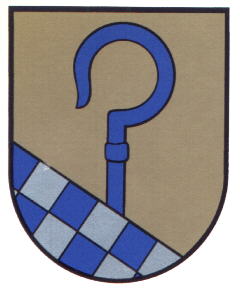Erlinghausen: Difference between revisions
Jump to navigation
Jump to search
Knorrepoes (talk | contribs) m (Text replacement - "'''↵| ↵|-↵|'''English''' ↵| {{blazon wanted}}↵|}" to "''' | blazon wanted |- |'''English''' | blazon wanted |}") |
Knorrepoes (talk | contribs) m (Text replacement - "{{media}}" to " {{de1}} {{media1}}") |
||
| Line 25: | Line 25: | ||
The arms show in the base a checquered part, which is derived from the arms of the Von Horhusen family, which owned several possessions in the village in early medieval times. In 1201 Beringer von Horhusen donates nine farms to the Marsberg convent. The crosier thus refers to the convent, which for many centuries owned a large part of the municipality. | The arms show in the base a checquered part, which is derived from the arms of the Von Horhusen family, which owned several possessions in the village in early medieval times. In 1201 Beringer von Horhusen donates nine farms to the Marsberg convent. The crosier thus refers to the convent, which for many centuries owned a large part of the municipality. | ||
{{ | |||
{{de1}} | |||
{{media1}} | |||
[[Civic Heraldry Literature - Germany|'''Literature''']]: Belke et al., 1986 | [[Civic Heraldry Literature - Germany|'''Literature''']]: Belke et al., 1986 | ||
Revision as of 10:51, 26 December 2022
This page is part of the German heraldry portal Deutsche Wappensammlung |
Heraldry of the World |
|
German heraldry:
|
Selected collector's items from Germany:
|
ERLINGHAUSEN
State : Nordrhein-Westfalen
District (Kreis) : Hochsauerlandkreis (until 1975 Brilon)
Amt : Amt Niedermarsberg
Incorporated into : 1975 Marsberg
| German | blazon wanted |
| English | blazon wanted |
Origin/meaning
The arms were officially granted on July 6, 1967.
The arms show in the base a checquered part, which is derived from the arms of the Von Horhusen family, which owned several possessions in the village in early medieval times. In 1201 Beringer von Horhusen donates nine farms to the Marsberg convent. The crosier thus refers to the convent, which for many centuries owned a large part of the municipality.
Literature: Belke et al., 1986


